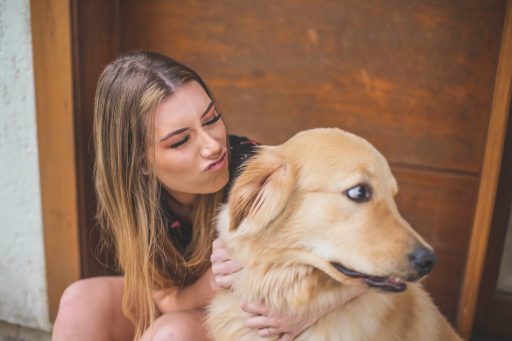
Dog side-eye, also known as whale eye, is when a dog looks at you or something else out of the corner of their eye, with the whites of their eyes showing. It’s a common body language cue that dogs use to communicate a variety of emotions, including:
Contents
Discomfort or anxiety:
If your dog is giving you side-eye while also showing other signs of stress, such as cowering, panting, or licking their lips, it’s a good sign that they’re feeling uncomfortable or anxious. This could be due to a variety of factors, such as a new person or animal in the environment, a loud noise, or a stressful situation.
Curiosity or playfulness:
Dogs may also give side-eye when they’re curious about something or feeling playful. For example, if you’re opening a bag of treats and your dog gives you a side-eye, they’re probably wondering what you’re doing and hoping they’ll get a treat.
Dominance or aggression:
In some cases, side-eye can also be a sign of dominance or aggression. For example, if a dog is guarding a toy or food and another dog approaches, they may give side-eye as a warning.
It’s important to pay attention to the context in which your dog is giving you side-eye to accurately interpret its meaning. If you’re not sure what your dog is trying to communicate, it’s always best to err on the side of caution and give them some space.
Here are some tips for dealing with a dog that is giving you side-eye:
- Assess the situation: Try to figure out what might be causing your dog to feel uncomfortable or anxious. Once you know the cause, you can try to remove it or reduce its impact.
- Give your dog space: If your dog is feeling overwhelmed, give them some space to de-stress. This may mean moving to a different room or going for a walk.
- Speak to your veterinarian: If you’re concerned about your dog’s side-eye or other behaviour problems, talk to your veterinarian.
What causes dogs to give the side-eye?
Dogs give the side-eye for a variety of reasons, including:
- To observe their surroundings without being seen: Dogs are predators by nature, and they use their keen eyesight to scan their environment for potential threats or prey. Giving the side-eye allows them to do this without alerting their prey or revealing their position to potential predators.
- To communicate with other dogs: Dogs use a variety of body language cues to communicate with each other, including side-eye. For example, a dog may give a side-eye to another dog as a warning to stay away.
- To express their emotions: Dogs can use side-eye to express a variety of emotions, including fear, anxiety, curiosity, and playfulness. For example, a dog may give a side-eye to their owner if they’re feeling anxious about something.
In some cases, side-eye can also be a sign of dominance or aggression. For example, a dog may give a side-eye to another dog if they’re trying to assert their dominance.
It’s important to pay attention to the context in which your dog is giving you side-eye to accurately interpret its meaning. If you’re not sure what your dog is trying to communicate, it’s always best to err on the side of caution and give them some space.
Here are some tips for interpreting your dog’s side-eye:
- Look for other body language cues: Is your dog also showing other signs of fear, anxiety, or aggression? For example, are they cowering, panting, or growling?
- Consider the situation: Are there any potential threats or stressors in the environment? For example, are there other dogs or people around? Is there a loud noise?
- Pay attention to your behaviour: Are you doing anything that might be making your dog feel uncomfortable or anxious? For example, are you yelling or making sudden movements?
If you’re still unsure what your dog is trying to communicate, it’s always best to ask a qualified dog trainer or behaviorist for help.
How to react to a dog giving you the side-eye
If your dog gives you the side-eye, the best way to respond is to pay attention to the context and try to understand what they’re trying to tell you. Here are some tips:
- Try to make the grooming process as positive and stress-free as possible. For example, use gentle strokes and give your dog plenty of breaks.
- They may be begging for food or feeling anxious about you eating without them. Try to give your dog a small portion of your food or a treat to ease their anxiety.
- They may be feeling jealous or insecure. Try to include your dog in the play session and give them plenty of attention.
FAQ
What is whale eye in dogs?
It is important to pay attention to the context in which your dog is giving you whale eye to accurately interpret its meaning. For example, if your dog is giving you whale eye while also showing other signs of stress, such as cowering, panting, or licking their lips, it’s a good sign that they’re feeling uncomfortable or anxious.
On the other hand, if your dog is giving you whale eye while also wagging their tail and playing, it’s more likely that they’re simply curious or playful.If you’re not sure what your dog is trying to communicate with whale eye, it’s always best to err on the side of caution and give them some space. This is especially important if your dog is also showing other signs of stress or aggression.
Is it bad if my dog is giving side-eye?
Whether or not it’s bad if your dog is giving you side-eye depends on the context. In some cases, side-eye is simply a way for dogs to communicate their emotions, such as curiosity, playfulness, or anxiety. However, in other cases, side-eye can be a sign of dominance or aggression.
Dog breeds with shorter snouts and squished-up faces, such as boxers, pugs, and bulldogs, are more likely to show the whites of their eyes than other breeds. This is due to the structure of their faces, and not necessarily because they are giving you side-eye or whale eye.
To confirm that a dog is giving you side-eye, look for other body language cues, such as:
- Averted gaze
- Ears pinned back
- Tail tucked between the legs
- Raised hackles
- Growling or snapping
If you see any of these signs, it is best to give the dog space and avoid interacting with it.
My dog always has a whale eye!
Dogs with shorter snouts and squished-up faces, such as boxers, pugs, and bulldogs, may show the whites of their eyes more often than other breeds. This is because of the structure of their faces and does not necessarily mean that they are giving you side-eye.
If you are unsure whether a dog is giving you a side-eye, look for other body language cues, such as averted gaze, pinned-back ears, a tucked tail, raised hackles, growling, or snapping. If you see any of these signs, it is best to give the dog space and avoid interacting with it.






